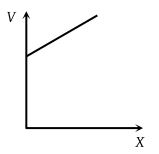In a hollow spherical shell potential (V) changes with respect to distance (r) from centre
(1) 
(2) 
(3) 
(4) 




Between the plates of a parallel plate capacitor a dielectric plate is introduced just to fill the space between the plates. The capacitor is charged and later disconnected from the battery. The dielectric plate is slowly drawn out of the capacitor parallel to the plates. The plot of the potential difference across the plates and the length of the dielectric plate drawn out is
(1)
(2)
(3)
(4)
Equipotential surfaces are shown in figure. Then the electric field strength will be
(1) 100 Vm–1 along X-axis
(2) 100 Vm–1 along Y-axis
(3) 200 Vm–1 at an angle 120o with X-axis
(4) 50 Vm–1 at an angle 120o with X-axis
A condenser of 2μF capacitance is charged steadily from 0 to 5 Coulomb. Which of the following graphs correctly represents the variation of potential difference across its plates with respect to the charge on the condenser?
(1)
(2)
(3)
(4)
The figure gives the electric potential V as a function of distance through five regions on x-axis. Which of the following is true for the electric field E in these regions
(1)
(2) and
(3) and
(4)
The variation of potential with distance R from a fixed point is as shown below. The electric field at R = 5 m is
(1) 2.5 volt/m
(2) –2.5 volt/m
(3) 2/5 volt/m
(4) –2/5 volt/m
A network of four capacitors of capacity equal to and C4 = 4 C are connected in a battery as shown in the figure. The ratio of the charges on C2 and C4 is
(1)
(2)
(3)
(4)
A fully charged capacitor has a capacitance ‘C’. It is discharged through a small coil of resistance wire embedded in a thermally insulated block of specific heat capacity ‘s’ and mass ‘m’. If the temperature of the block is raised by ‘ΔT’, the potential difference ‘V’ across the capacitance is
(1)
(2)
(3)
(4)
The plates of a parallel plate condenser are pulled apart with a velocity v. If at any instant their mutual distance of separation is d, then the magnitude of the time rate of change of capacity depends on d as follows
(1) 1/d
(2) 1/d2
(3) d2
(4) d
A capacitor of capacitance C1 = 1 μF can withstand maximum voltage V1 = 6kV (kilo-volt) and another capacitor of capacitance C2 = 3 μF can withstand maximum voltage V2 = 4 kV. When the two capacitors are connected in series, the combined system can withstand a maximum voltage of
(1) 4 kV
(2) 6 kV
(3) 8 kV
(4) 10 kV


















